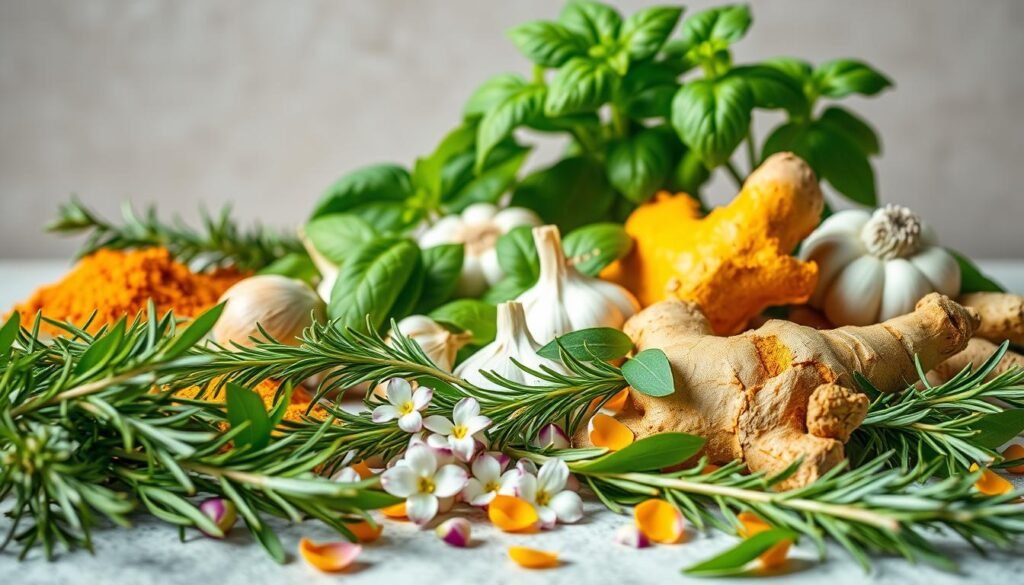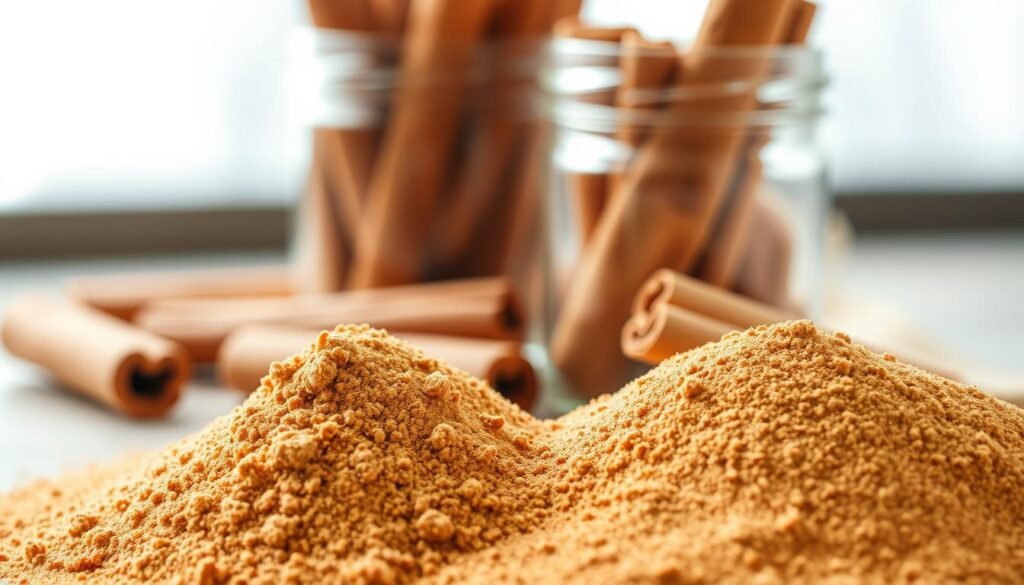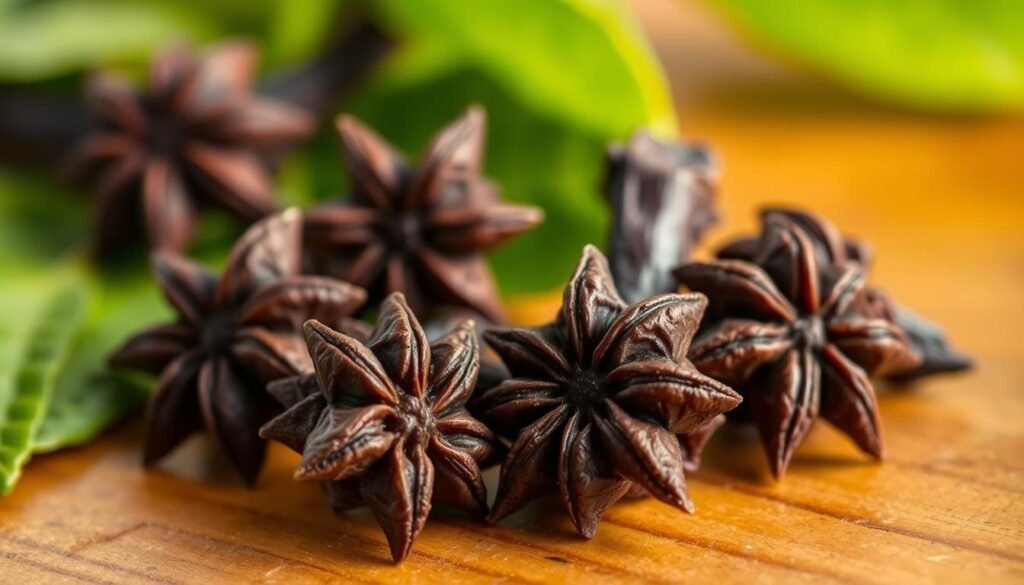Chronic inflammation can lead to a myriad of health issues, from arthritis to cardiovascular disease. What if the key to mitigating this risk lay not in medication, but in the spices on your kitchen shelf?
Inflammation is a natural response, but when it becomes chronic, it can have serious health implications. Fortunately, incorporating certain herbs and spices into your diet can help keep inflammation at bay.
The foods you eat play a significant role in managing inflammation. By adding inflammation-fighting herbs to your meals, you not only enhance flavor but also contribute to a healthier you.
Key Takeaways
- Chronic inflammation can lead to serious health issues.
- Diet plays a crucial role in managing inflammation.
- Certain herbs and spices have natural anti-inflammatory properties.
- Incorporating these herbs into your diet can help reduce inflammation.
- A healthier diet can lead to overall well-being.
Understanding Inflammation and Its Impact on Health
The impact of inflammation on our health is multifaceted, affecting various bodily systems. Inflammation is a natural response of the body’s immune system, designed to protect against harm, infection, and injury. However, when this response becomes dysregulated, it can lead to a range of health issues.
To comprehend the role of inflammation-fighting herbs, it’s essential to differentiate between acute and chronic inflammation. Acute inflammation is a short-term response to immediate threats such as cuts, infections, or allergens. It’s characterized by redness, swelling, warmth, and pain in the affected area. This type of inflammation is a protective mechanism that aids in the healing process.
Acute vs. Chronic Inflammation
In contrast, chronic inflammation is a prolonged and often low-grade inflammatory response that can persist for months or even years. It’s associated with various lifestyle factors, including diet, stress, and environmental exposures. Chronic inflammation can lead to tissue damage and is linked to numerous chronic diseases.
- Cardiovascular disease
- Diabetes
- Arthritis
- Certain types of cancer
Common Inflammatory Conditions
Several health conditions are characterized by or associated with chronic inflammation. These include:
- Rheumatoid arthritis, where the immune system attacks the lining of the joints
- Asthma, a condition where airways become inflamed and constricted
- Inflammatory bowel disease (IBD), encompassing conditions like Crohn’s disease and ulcerative colitis
Understanding the differences between acute and chronic inflammation, as well as recognizing common inflammatory conditions, is crucial for appreciating the potential benefits of herbs for reducing inflammation. By incorporating these natural remedies into one’s health regimen, individuals may be able to mitigate the effects of chronic inflammation and improve their overall well-being.
The Science Behind 10 Herbs That Fight Inflammation Naturally
Nature provides a diverse array of herbs that have been found to possess anti-inflammatory properties, offering potential health benefits. The use of these herbs as natural remedies for inflammation has been a longstanding practice in various cultures, now backed by emerging scientific evidence.

Mechanisms of Herbal Anti-Inflammatory Action
Herbs combat inflammatory processes through various mechanisms, primarily by modulating the body’s immune response and reducing the production of pro-inflammatory cytokines. Bioactive compounds within these herbs are responsible for their anti-inflammatory effects.
For instance, certain herbs contain flavonoids and terpenes that have been shown to inhibit the activity of enzymes like COX-2, which plays a significant role in the inflammatory process. Other herbs may work by scavenging free radicals, thereby reducing oxidative stress and subsequent inflammation.
“The anti-inflammatory properties of herbs are attributed to their complex mixture of bioactive compounds, which interact with biological pathways to mitigate inflammation.”
Bioactive Compounds Responsible for Anti-Inflammatory Effects
The bioactive compounds in anti-inflammatory herbs can be broadly categorized into several classes, including phenolic acids, flavonoids, and terpenoids. Each of these classes has distinct mechanisms through which they exert their anti-inflammatory effects.
| Compound Class | Examples | Anti-Inflammatory Mechanism |
|---|---|---|
| Phenolic Acids | Curcumin, Rosmarinic Acid | Inhibition of pro-inflammatory enzymes |
| Flavonoids | Quercetin, Kaempferol | Antioxidant activity, modulation of immune response |
| Terpenoids | Boswellic Acids, Ginkgolides | Inhibition of inflammatory pathways |
Understanding the bioactive compounds and their mechanisms can help in selecting the most appropriate herbs for managing inflammation. It’s also crucial to consider the synergistic effects of combining different herbs, as well as their potential interactions with other medications.
Turmeric: The Golden Anti-Inflammatory Powerhouse
Among the myriad of inflammation-fighting plants, turmeric stands out as a potent natural remedy. Turmeric, scientifically known as Curcuma longa, has been a cornerstone in traditional medicine for centuries, particularly in Asian cultures. Its vibrant yellow color is due to a compound called curcumin, which is also responsible for its medicinal properties.
Curcumin and Its Inflammation-Fighting Properties
Curcumin is the active ingredient in turmeric that has been extensively studied for its anti-inflammatory effects. It works by inhibiting various molecules that play a role in inflammation, making it a potential natural remedy for conditions characterized by chronic inflammation. Research has shown that curcumin can help reduce the symptoms of arthritis, improve wound healing, and even exert anti-cancer effects.
Ways to Enhance Turmeric Absorption
One of the challenges with consuming turmeric or curcumin is its relatively poor bioavailability. However, certain dietary factors can enhance its absorption. Consuming turmeric with black pepper significantly improves curcumin bioavailability due to piperine, a compound in black pepper that inhibits the breakdown of curcumin in the liver. Additionally, taking turmeric with a fatty meal can also enhance absorption due to the lipophilic nature of curcumin.
| Method | Description | Benefit |
|---|---|---|
| Consuming with Black Pepper | Piperine in black pepper enhances curcumin absorption | Increased bioavailability of curcumin |
| Consuming with Fatty Meals | Lipophilic nature of curcumin is better absorbed with fats | Improved absorption of curcumin |
Recommended Dosage and Precautions
The optimal dosage of turmeric or curcumin can vary depending on the individual and the condition being treated. Typical dosages range from 500 mg to 2,000 mg of curcumin per day. However, it’s crucial to consult with a healthcare provider before starting any supplement regimen, especially for those on blood thinners or with gallbladder disease, as turmeric can exacerbate these conditions.
In conclusion, turmeric, with its active compound curcumin, is a powerful anti-inflammatory agent that can be incorporated into one’s diet or taken as a supplement. By understanding how to enhance its absorption and being aware of the recommended dosages, individuals can harness the benefits of turmeric for inflammation relief.
Ginger: A Warming Remedy for Inflammation
For those seeking natural remedies for inflammation, ginger stands out as a potent and warming solution. Ginger has been used for centuries in various cultures for its medicinal properties, particularly for its ability to alleviate nausea, pain, and inflammation.

Active Compounds in Ginger That Reduce Inflammation
Ginger’s anti-inflammatory effects are primarily attributed to its bioactive compounds, including gingerols and shogaols. These compounds have been shown to inhibit the production of pro-inflammatory cytokines and enzymes, thus reducing inflammation.
Gingerols, particularly 6-gingerol, are the most studied compounds for their anti-inflammatory properties. They work by inhibiting the pathways that lead to inflammation, making ginger a valuable natural anti-inflammatory herb.
Fresh vs. Dried Ginger for Inflammatory Relief
Both fresh and dried ginger can be used for inflammatory relief, each with its own benefits. Fresh ginger contains higher levels of gingerols, while dried ginger (or ginger powder) has a higher concentration of shogaols due to the drying process.
- Fresh ginger is ideal for making teas, adding to meals, or using in smoothies.
- Dried ginger is convenient for capsules or powdered form, which can be easily incorporated into daily routines.
Safe Usage Guidelines and Potential Interactions
While ginger is generally considered safe, it’s essential to follow safe usage guidelines. The recommended daily intake is typically around 1-2 grams of ginger.
Potential interactions can occur with blood-thinning medications and diabetes medications. Therefore, individuals on these medications should consult their healthcare provider before significantly increasing their ginger consumption.
By understanding the benefits and safe usage of ginger, individuals can harness its anti-inflammatory properties as part of a holistic approach to managing inflammation.
Boswellia: Ancient Resin with Modern Anti-Inflammatory Benefits
With a history that spans millennia, Boswellia has emerged as a powerful natural remedy for reducing inflammation. This ancient resin, derived from the Boswellia tree, has been a cornerstone in traditional medicine for centuries, particularly in Ayurvedic practices.
Anti-Inflammatory Effects of Boswellic Acids
Boswellia’s anti-inflammatory properties are primarily attributed to its boswellic acids. These compounds have been shown to inhibit inflammatory pathways in the body, making Boswellia an effective inflammation-fighting herb. Research has indicated that boswellic acids can:
- Inhibit the production of pro-inflammatory enzymes
- Reduce inflammation by inhibiting the NF-κB pathway
- Exhibit anti-inflammatory effects in various animal models
The efficacy of Boswellia in combating inflammation has positioned it among the best anti-inflammatory herbs available today.
Traditional and Contemporary Applications
Traditionally, Boswellia has been used to treat various inflammatory conditions, including arthritis, joint pain, and inflammatory bowel diseases. Its contemporary applications have expanded to include:
| Condition | Traditional Use | Modern Application |
|---|---|---|
| Arthritis | Relieve joint pain and inflammation | Dietary supplements for osteoarthritis |
| Inflammatory Bowel Disease | Treat digestive issues | Complementary therapy for Crohn’s disease and ulcerative colitis |
| Skin Conditions | Topical application for wounds and inflammation | Cosmetic products for anti-aging and skin health |
Selecting Quality Boswellia Supplements
When choosing Boswellia supplements, it’s crucial to consider the following factors to ensure efficacy and safety:
- Look for products with standardized boswellic acid content
- Check for third-party testing and certification
- Be aware of the extraction process and its impact on bioavailability
By selecting high-quality Boswellia supplements, individuals can harness the anti-inflammatory benefits of this ancient resin in a modern context, making it a valuable addition to the list of herbs to reduce inflammation.
Cinnamon: More Than Just a Delicious Spice
Beyond its culinary uses, cinnamon has been recognized for its potential in reducing inflammation naturally. This spice, derived from the bark of the Cinnamomum tree, has been a staple in traditional medicine for centuries.
Anti-Inflammatory Mechanisms of Cinnamon
Cinnamon’s anti-inflammatory properties are primarily attributed to its bioactive compound, cinnamaldehyde. This compound has been shown to inhibit the production of pro-inflammatory cytokines, which are molecules that promote inflammation in the body. By reducing the levels of these cytokines, cinnamon can help mitigate inflammatory responses.
Cinnamon’s Role in Reducing Inflammation:
- Inhibits pro-inflammatory cytokines
- Antioxidant properties help reduce oxidative stress
- May improve insulin sensitivity, reducing inflammation associated with metabolic syndrome
Ceylon vs. Cassia Cinnamon for Health Benefits
There are two main types of cinnamon: Ceylon and Cassia. While both have anti-inflammatory properties, Ceylon cinnamon is considered to have more health benefits due to its lower coumarin content. Coumarin is a compound that can be toxic in high doses.
| Cinnamon Type | Coumarin Content | Health Benefits |
|---|---|---|
| Ceylon Cinnamon | Low | Higher safety profile, rich in antioxidants |
| Cassia Cinnamon | Higher | More readily available, still offers anti-inflammatory benefits |
Incorporating Cinnamon Into Your Daily Routine
Cinnamon can be easily incorporated into daily life through various means. Adding it to your morning oatmeal or yogurt is a delicious way to start the day. It can also be used in baking or as a spice in savory dishes.
Tips for Using Cinnamon:
- Sprinkle cinnamon on fruits or oatmeal
- Add to tea or coffee for an extra flavor boost
- Use in baking recipes for a warm, spicy flavor

By incorporating cinnamon into your diet, you can harness its anti-inflammatory properties to support overall health. As with any dietary change, it’s essential to consult with a healthcare provider, especially if you have any underlying health conditions.
Rosemary: Aromatic Herb with Powerful Anti-Inflammatory Effects
Rosemary, a staple in many kitchens, is more than just a flavorful addition to meals; it’s also a powerful herb for combating inflammation. This aromatic herb has been used for centuries in traditional medicine, and recent studies have highlighted its anti-inflammatory effects.
Rosemary’s Unique Anti-Inflammatory Compounds
Rosemary contains several compounds that contribute to its anti-inflammatory properties, with rosmarinic acid being one of the most significant. Rosmarinic acid has been shown to inhibit the production of inflammatory cytokines, which are molecules that promote inflammation in the body.
The anti-inflammatory effects of rosemary are not limited to rosmarinic acid alone; other compounds like carnosic acid and ursolic acid also play crucial roles. These compounds work synergistically to provide a robust defense against inflammation.
Culinary and Medicinal Applications
Rosemary can be incorporated into daily life in various ways, from culinary uses to medicinal applications. In the kitchen, rosemary can be used fresh or dried to add flavor to a variety of dishes, from roasted meats to soups and stews.
Medicinally, rosemary can be consumed as a tea, made by steeping dried rosemary leaves in hot water. This tea can help reduce inflammation and promote overall health.
Essential Oil vs. Dried Herb Benefits
Rosemary is available in two main forms: essential oil and dried herb. Both forms have their benefits, and the choice between them depends on the intended use.
| Form | Benefits | Usage |
|---|---|---|
| Essential Oil | Highly concentrated, potent anti-inflammatory effects | Aromatherapy, topical application (diluted) |
| Dried Herb | Easy to incorporate into cooking, tea, or supplements | Culinary, medicinal teas, capsules |
Rosemary essential oil is highly concentrated and should be used with caution. It’s ideal for aromatherapy or topical application when diluted with a carrier oil. On the other hand, dried rosemary is versatile and can be easily added to meals or made into tea.
In conclusion, rosemary is a valuable addition to an anti-inflammatory regimen, offering a range of benefits whether used in cooking or as a medicinal herb. Its unique compounds and versatility make it one of the best anti-inflammatory herbs available.
Green Tea: Sipping Your Way to Reduced Inflammation
Sipping on a warm cup of green tea is not only a comforting ritual but also a step towards reducing inflammation in the body. Green tea has been revered for its medicinal properties for centuries, and its anti-inflammatory effects are now backed by modern science.

Catechins and Their Anti-Inflammatory Properties
Green tea is rich in catechins, a type of antioxidant that has been shown to have potent anti-inflammatory effects. Among these catechins, epigallocatechin gallate (EGCG) is the most studied for its ability to modulate inflammatory pathways in the body. By reducing the production of pro-inflammatory molecules, catechins help in mitigating inflammation and potentially lowering the risk of chronic diseases associated with it.
Brewing Methods for Maximum Benefits
The way you brew your green tea can significantly impact its nutritional content and, consequently, its anti-inflammatory benefits. To maximize the catechin content, it’s recommended to brew green tea in water that’s not quite boiling, around 160°F to 170°F. Steeping the tea for 2 to 3 minutes is ideal; longer steeping times can result in a bitter taste without adding much benefit.
Using high-quality green tea leaves and filtered water can also enhance the tea’s anti-inflammatory properties. Experimenting with different brewing times and temperatures can help you find the perfect balance for your taste preferences while reaping the benefits of green tea.
Daily Consumption Guidelines and Considerations
Incorporating green tea into your daily routine can be a simple and enjoyable way to support your health. While there’s no one-size-fits-all recommendation for daily consumption, drinking 2 to 3 cups per day is generally considered safe and beneficial for most adults. However, it’s essential to be mindful of your overall caffeine intake and how green tea might interact with any medications you’re taking.
For those new to green tea, starting with a lower amount and gradually increasing can help assess tolerance. Additionally, choosing a high-quality, organic green tea can minimize exposure to pesticides and other contaminants, ensuring you get the most out of this natural anti-inflammatory herb.
Holy Basil (Tulsi): Sacred Herb for Fighting Inflammation
In the realm of Ayurvedic healing, Holy Basil stands out as a powerful remedy for reducing inflammation and stress. This sacred herb, also known as Tulsi, has been used for centuries in traditional Indian medicine to promote overall well-being.
Adaptogenic Properties and Inflammation Reduction
Holy Basil is considered an adaptogen, meaning it helps the body adapt to stress and promotes balance in the body’s physiological processes. Its adaptogenic properties play a crucial role in reducing inflammation by mitigating the body’s stress response, which is often linked to inflammatory conditions.
The active compounds in Holy Basil, such as eugenol and rosmarinic acid, have been shown to possess anti-inflammatory properties. These compounds work by inhibiting the production of pro-inflammatory enzymes and cytokines, thereby reducing inflammation.
Traditional Ayurvedic Uses for Inflammatory Conditions
In Ayurvedic medicine, Holy Basil has been traditionally used to treat various inflammatory conditions, including arthritis and respiratory issues. Its leaves are often consumed as a tea or used in cooking to harness its anti-inflammatory benefits.
The herb is also believed to have a positive impact on the immune system, helping to regulate immune responses and prevent excessive inflammation. This makes it a valuable natural remedy for maintaining overall health.
Modern Preparations and Availability
Today, Holy Basil is available in various forms, including capsules, teas, and tinctures. These modern preparations make it easy to incorporate Holy Basil into one’s daily routine for inflammation relief.
When selecting a Holy Basil supplement, it’s essential to choose products from reputable sources to ensure quality and potency. Look for products that are standardized for their eugenol content, as this compound is a key contributor to the herb’s anti-inflammatory effects.
Incorporating Holy Basil into your health regimen can be a natural and effective way to combat inflammation. Whether consumed as a tea, added to meals, or taken as a supplement, this sacred herb offers a range of benefits for those seeking to reduce inflammation and promote overall well-being.
Cloves: Small But Mighty Inflammation Fighters
Cloves, a staple in many kitchens, are not just for flavor; they are also potent inflammation fighters. Their active compound, eugenol, is the key to their anti-inflammatory properties.
Eugenol and Its Anti-Inflammatory Mechanisms
Eugenol, found abundantly in cloves, has been studied for its ability to reduce inflammation. It works by inhibiting the production of pro-inflammatory enzymes, thus providing relief from inflammatory conditions.
Key benefits of eugenol include:
- Reducing pain and inflammation
- Antioxidant properties
- Antimicrobial effects
Topical and Internal Applications
Cloves can be used both topically and internally to harness their anti-inflammatory benefits.
For topical use, clove oil can be applied to the skin to relieve pain and reduce inflammation. However, it’s essential to dilute it with a carrier oil to avoid skin irritation.
Internally, cloves can be consumed as a spice in cooking or as a supplement. Clove tea is another popular method, offering a soothing way to enjoy the benefits of cloves.

Proper Usage and Safety Considerations
While cloves are generally safe, there are precautions to be taken. Eugenol, in high concentrations, can be toxic. Therefore, it’s crucial to use clove oil and supplements judiciously.
Recommended usage includes:
- Diluting clove oil with a carrier oil for topical application
- Consuming cloves in moderation as part of a balanced diet
- Consulting with a healthcare provider before using clove supplements, especially if you’re on medication
By incorporating cloves into your anti-inflammatory regimen, you can tap into their natural healing properties. Whether used topically or consumed internally, cloves offer a versatile and effective way to combat inflammation.
Black Pepper: The Everyday Spice with Surprising Benefits
Black pepper is not just a seasoning; it’s a powerful tool in the fight against inflammation. This everyday spice contains piperine, a compound that not only enhances the flavor of food but also has significant anti-inflammatory properties.
Piperine’s Role in Fighting Inflammation
Piperine, the active compound in black pepper, has been shown to have anti-inflammatory effects. It works by inhibiting certain enzymes and pathways that lead to inflammation in the body. This makes black pepper a valuable addition to an anti-inflammatory diet.
Key Benefits of Piperine:
- Reduces inflammation by inhibiting pro-inflammatory enzymes
- Enhances the bioavailability of other anti-inflammatory compounds
- Has antioxidant properties that complement its anti-inflammatory effects
Synergistic Effects with Other Anti-Inflammatory Herbs
One of the most significant benefits of black pepper is its ability to enhance the bioavailability of other herbs and nutrients. When combined with turmeric, for example, black pepper can increase the absorption of curcumin, turmeric’s active compound, by up to 2,000%. This synergistic effect makes black pepper a crucial component of many anti-inflammatory herbal blends.
| Herb | Active Compound | Effect with Black Pepper |
|---|---|---|
| Turmeric | Curcumin | Increased bioavailability by up to 2,000% |
| Ginger | Gingerol | Enhanced anti-inflammatory effect |
| Cinnamon | Cinnamaldehyde | Improved absorption and efficacy |
Incorporating Black Pepper for Maximum Benefit
To reap the anti-inflammatory benefits of black pepper, it’s simple to incorporate it into your daily meals. Add freshly ground black pepper to your dishes, or consider supplementing with piperine extracts if you have specific health concerns.
Tips for Incorporation:
- Add black pepper to soups and stews for an anti-inflammatory boost
- Mix black pepper with olive oil and garlic for a healthy salad dressing
- Use black pepper as a seasoning for roasted vegetables
By incorporating black pepper into your diet, you’re not just enhancing the flavor of your meals; you’re also taking a significant step towards reducing inflammation and improving your overall health.
Lifestyle Factors That Enhance Herbal Anti-Inflammatory Effects
To maximize the potential of herbs for inflammation relief, it’s crucial to understand how diet, exercise, and stress management play a role in enhancing their anti-inflammatory properties. By adopting a comprehensive approach to health, individuals can significantly improve the effectiveness of natural anti-inflammatory herbs.
Dietary Approaches That Complement Anti-Inflammatory Herbs
A diet rich in whole foods, fruits, vegetables, and healthy fats can significantly enhance the anti-inflammatory effects of herbal remedies. Certain foods have been shown to have synergistic effects when combined with herbal anti-inflammatory treatments.
| Food | Anti-Inflammatory Benefit |
|---|---|
| Fatty Fish | Rich in omega-3 fatty acids, which reduce inflammation |
| Berries | High in antioxidants that combat oxidative stress |
| Olive Oil | Contains oleocanthal, which has anti-inflammatory properties |
Exercise and Stress Management for Inflammation Control
Regular physical activity and effective stress management techniques are crucial for controlling inflammation. Exercise has been shown to reduce systemic inflammation, while stress management practices like meditation and yoga can help mitigate the negative impact of stress on the body’s inflammatory response.

Creating a Holistic Anti-Inflammatory Lifestyle
By combining natural anti-inflammatory herbs with a balanced diet, regular exercise, and stress management, individuals can create a powerful defense against chronic inflammation. This holistic approach not only enhances the effectiveness of herbal remedies but also promotes overall health and well-being.
In conclusion, lifestyle factors play a significant role in enhancing the effects of herbal remedies for inflammation. By making informed choices about diet, exercise, and stress management, individuals can maximize the benefits of herbs for inflammation relief and move towards a healthier, more balanced lifestyle.
When to Consult Healthcare Providers About Herbal Anti-Inflammatories
While incorporating herbal anti-inflammatories into your health regimen can be beneficial, it’s crucial to understand when to seek professional advice. Herbs to reduce inflammation, such as turmeric and ginger, are popular for their health benefits, but they can also interact with medications or have adverse effects in certain health conditions.
Potential Herb-Drug Interactions
Some inflammation-fighting herbs can interact with prescription medications, either enhancing their effects or reducing their efficacy. For instance, turmeric can interact with blood thinners, while ginger may affect blood sugar levels. It’s essential to consult with a healthcare provider before combining herbal remedies with conventional medications.
- Discuss your medication regimen with your healthcare provider to avoid potential interactions.
- Be aware of the herbs you’re using and their potential effects on your health.
- Monitor your body’s response to new herbal supplements and report any adverse effects.
Special Considerations for Specific Health Conditions
Certain health conditions require special consideration when using herbs to reduce inflammation. For example, individuals with bleeding disorders should be cautious with herbs that have anticoagulant properties, such as boswellia. Pregnant or breastfeeding women should also consult their healthcare provider before using any herbal anti-inflammatories.
- If you have a chronic health condition, consult your healthcare provider before starting any new herbal supplement.
- Be cautious with herbal remedies if you’re planning surgery, as some can affect bleeding or interact with anesthesia.
- Keep your healthcare provider informed about any changes in your health or supplement routine.
By being aware of the potential risks and taking proactive steps, you can safely incorporate the best anti-inflammatory herbs into your health regimen. Always consult with a healthcare professional to ensure that your use of herbal anti-inflammatories is appropriate for your specific health needs.
Conclusion
Incorporating the 10 herbs that fight inflammation naturally into your diet can be a significant step towards reducing inflammation and promoting overall health. These natural remedies for inflammation, including turmeric, ginger, and green tea, offer a holistic approach to managing inflammatory conditions.
By understanding how to use these herbs for inflammation relief, individuals can take control of their health. Whether through culinary applications or supplements, these herbs provide a range of benefits that can complement a healthy lifestyle.
As discussed, combining these natural remedies with lifestyle factors such as a balanced diet, regular exercise, and stress management can enhance their anti-inflammatory effects. This integrated approach can lead to improved overall well-being.
Embracing these herbs for inflammation relief is a step towards a healthier, more balanced life. By making informed choices about incorporating these natural remedies into daily routines, individuals can harness the power of nature to combat inflammation.

